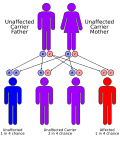Archaeological excavation
A rare genetic disorder affecting skeletal development
Antley–Bixler syndrome is a rare genetic disorder characterized by craniosynostosis, skeletal dysplasia, and other systemic abnormalities. It is named after Raymond Antley and David Bixler, who first described the condition in 1975. The syndrome is associated with mutations in the FGFR2 and POR genes, leading to abnormal development of bones and other tissues.
Presentation[edit]
Individuals with Antley–Bixler syndrome typically present with a variety of congenital anomalies. The most prominent features include:
- Craniosynostosis: Premature fusion of the cranial sutures, leading to an abnormal head shape and potential intracranial pressure issues.
- Midface hypoplasia: Underdevelopment of the midfacial region, which can result in respiratory difficulties and feeding problems.
- Radiohumeral synostosis: Fusion of the radius and humerus bones, limiting elbow movement.
- Femoral bowing: Curvature of the femur, which can affect mobility.
- Joint contractures: Stiffness and limited range of motion in various joints.
Additional features may include genital anomalies, renal malformations, and cardiac defects.
Genetics[edit]
Antley–Bixler syndrome can be inherited in an autosomal recessive or autosomal dominant manner, depending on the underlying genetic mutation. The autosomal recessive form is often associated with mutations in the POR gene, which is involved in steroidogenesis and drug metabolism. The autosomal dominant form is linked to mutations in the FGFR2 gene, which plays a critical role in bone development.
Diagnosis[edit]
Diagnosis of Antley–Bixler syndrome is based on clinical evaluation, radiographic imaging, and genetic testing. X-rays can reveal characteristic skeletal abnormalities, while genetic testing can confirm mutations in the FGFR2 or POR genes.
Management[edit]
Management of Antley–Bixler syndrome is multidisciplinary, involving pediatricians, geneticists, orthopedic surgeons, and other specialists. Treatment focuses on addressing specific symptoms and may include:
- Surgical intervention for craniosynostosis and other skeletal deformities.
- Physical therapy to improve joint mobility and muscle strength.
- Respiratory support for individuals with airway obstruction.
- Hormonal therapy for those with steroidogenesis defects.
Prognosis[edit]
The prognosis for individuals with Antley–Bixler syndrome varies depending on the severity of the condition and the presence of associated anomalies. Early intervention and comprehensive management can improve quality of life and functional outcomes.
Related pages[edit]
Gallery[edit]
-
Autosomal recessive inheritance pattern
Ad. Transform your life with W8MD's Budget GLP-1 injections from $75


W8MD offers a medical weight loss program to lose weight in Philadelphia. Our physician-supervised medical weight loss provides:
- Weight loss injections in NYC (generic and brand names):
- Zepbound / Mounjaro, Wegovy / Ozempic, Saxenda
- Most insurances accepted or discounted self-pay rates. We will obtain insurance prior authorizations if needed.
- Generic GLP1 weight loss injections from $75 for the starting dose.
- Also offer prescription weight loss medications including Phentermine, Qsymia, Diethylpropion, Contrave etc.
NYC weight loss doctor appointmentsNYC weight loss doctor appointments
Start your NYC weight loss journey today at our NYC medical weight loss and Philadelphia medical weight loss clinics.
- Call 718-946-5500 to lose weight in NYC or for medical weight loss in Philadelphia 215-676-2334.
- Tags:NYC medical weight loss, Philadelphia lose weight Zepbound NYC, Budget GLP1 weight loss injections, Wegovy Philadelphia, Wegovy NYC, Philadelphia medical weight loss, Brookly weight loss and Wegovy NYC
|
WikiMD's Wellness Encyclopedia |
| Let Food Be Thy Medicine Medicine Thy Food - Hippocrates |
Medical Disclaimer: WikiMD is not a substitute for professional medical advice. The information on WikiMD is provided as an information resource only, may be incorrect, outdated or misleading, and is not to be used or relied on for any diagnostic or treatment purposes. Please consult your health care provider before making any healthcare decisions or for guidance about a specific medical condition. WikiMD expressly disclaims responsibility, and shall have no liability, for any damages, loss, injury, or liability whatsoever suffered as a result of your reliance on the information contained in this site. By visiting this site you agree to the foregoing terms and conditions, which may from time to time be changed or supplemented by WikiMD. If you do not agree to the foregoing terms and conditions, you should not enter or use this site. See full disclaimer.
Credits:Most images are courtesy of Wikimedia commons, and templates, categories Wikipedia, licensed under CC BY SA or similar.
Translate this page: - East Asian
中文,
日本,
한국어,
South Asian
हिन्दी,
தமிழ்,
తెలుగు,
Urdu,
ಕನ್ನಡ,
Southeast Asian
Indonesian,
Vietnamese,
Thai,
မြန်မာဘာသာ,
বাংলা
European
español,
Deutsch,
français,
Greek,
português do Brasil,
polski,
română,
русский,
Nederlands,
norsk,
svenska,
suomi,
Italian
Middle Eastern & African
عربى,
Turkish,
Persian,
Hebrew,
Afrikaans,
isiZulu,
Kiswahili,
Other
Bulgarian,
Hungarian,
Czech,
Swedish,
മലയാളം,
मराठी,
ਪੰਜਾਬੀ,
ગુજરાતી,
Portuguese,
Ukrainian
